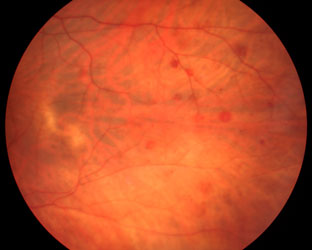What is ocular ischemic syndrome?
With age, most of us develop atherosclerotic plaques in our larger blood vessels. Narrowing of the vessels supplying the brain, the carotid arteries, can lead to a stroke. Carotid disease can also cause a chronic lack of blood supply to the eyes which is called the ocular ischemic syndrome.
How is the ocular ischemic syndrome diagnosed?
 Ocular ischemia is suspected during a careful dilated eye examination. Patients will usually have asymptomatic retinal hemorrhages. Carotid Doppler and ultrasound testing is then ordered to diagnose a narrowing of these vessels.
Ocular ischemia is suspected during a careful dilated eye examination. Patients will usually have asymptomatic retinal hemorrhages. Carotid Doppler and ultrasound testing is then ordered to diagnose a narrowing of these vessels.
Patients can develop the growth of new retinal blood vessels (retinal neovascularization) similar to those found in patients with proliferative diabetic retinopathy. These can bleed and cause vision loss from vitreous hemorrhage. Some patients can also develop new blood vessel growth on the iris (rubeosis iridis), causing neovascular glaucoma as occurs in patients with ischemic central retinal vein occlusions. Eye pain, uveitis, and low eye pressure can also occur.
How is the ocular ischemic syndrome treated?
If critical carotid blockages are found, urgent referral to a vascular surgeon for carotid endarterectomy surgery can prevent a stroke or even be life-saving. For less severe blockages patients are often treated with blood thinners.
New blood vessel growth on the iris and retina are often curative following carotid surgery. Panretinal photocoagulation (as performed in eyes with proliferative diabetic retinopathy) or intravitreal injections (as performed for eyes with central retinal vein occlusions) are usually successful as well.
View more retina images at Retina Rocks, the world’s largest online multimedia retina image library and bibliography repository.



